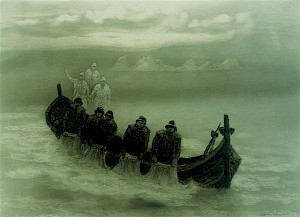Nordic House

Saturday, January 9th 2016 - Saturday, February 6th 2016
Upper and lower foyer
Arctic seascapes, Icelandic lava fields, Denmark's oldest allotment gardens, women fishing on the Baltic and a subsidence-threatened Swedish mining town – all these landscapes featured in a pioneering Nordic art exhibition during the 2015 Edinburgh Festival. Now the Nordic House is moving north to Shetland – and closer to the landscapes that inspired this exhibition.
From 9th January to 14th February, the exhibition will be on show in the upper and lower foyer of the Shetland Museum and Archives.
Sponsors for this exhibition are: The Nordic Culture Fund, who also sponsored the original exhibition, Feisty Productions, Grieg Seafood Shetland, SERCO Northlink, Shetland Amenity Trust, Flybe and
The exhibition includes reproductions of work by;
Kaare Espolin Johnson (1907-1994) – who produced striking images of people & seascapes from his native Finnmark in northern Norway despite being almost blind.
- Johannes Sveinsson Kjarval (1885-1972) – an orphan and fisherman who became Iceland’s most prolific painter using a variety of styles to depict landscape and lava formation.
- Åland women – photographs from three collections showing women fishing, working as merchant seamen and sailing from the Finnish Åland islands to Helsinki in the 1920s.
- Vennelyst – photos of Copenhagen’s oldest allotment gardens where families traditionally moved to live for the summer – comparing life at the turn of two centuries -- 1900 and 2000.
- Kiruna – photos and a film of the Arctic Swedish mining town, currently being moved 4kms, building by building, to avoid a massive crack in the earth caused by subsidence.
The Nordic House will be formally opened on Friday 8th January by Jean Urquhart MSP, and Nordic House Director Lesley Riddoch will explain the background to the selection. The exhibition will be freely open to the public from Saturday 9th January.
According to the Icelandic Consul in Scotland, Kristin Hannesdottir; “Jóhannes Sveinsson Kjarval is without doubt the most important 20th century Icelandic artist. He holds a special place as one of the most highly regarded artists of the nation. His roots lay in the old Icelandic rural community, but his life and art are tightly bound to the cultural awakening of the nation in the first half of the 20th century. Kjarval is famous for his interpretation of Icelandic nature. He captured the beauty and the mystical quality of the land. His depiction of lava emphasizing its surface and tactility gave a new dimension to the Icelanders' own perception of nature. Kjarvalsstaðir, a part of the Reykjavik Art Museum, is a museum dedicated to Kjarval with a permanent exhibition of his work. This is a very rare opportunity to see Kjarval’s work outside Iceland.”
Richard Demarco – who introduced Norwegian, Icelandic and Faroese artists to Scotland as founder and director of The Traverse Theatre Art Gallery in the 1960s opened the Nordic House exhibition in Edinburgh by describing Kjarval as “the Nordic Van Gogh”.
According to the Norwegian Consul in Scotland, Mona Røhne; “Kaare Espolin Johnson has a special place in the heart of Northerners. Like no other he has portrayed nature, humans and the living conditions of the north of Norway.”
Nordic House Director Lesley Riddoch said; “Since I first travelled to Iceland and the Far North of Norway I’ve admired Kjarval and Espolin Johnson - artists who battled poverty and blindness to demonstrate an intimacy with landscapes usually dismissed by outsiders as icy wastelands. I think anyone who loves the island landscapes of Scotland will instantly connect with their vivid portrayal of remote, northern scenery and fishing life. Photographs of women fishing on the Baltic and families “camped out” for the summer in Copenhagen allotments both speak of societies less restricted by convention. The extraordinary plan to move the Arctic Swedish town of Kiruna over the next two decades because of mining subsidence also offers a glimpse of the enduring human resilience at work in the High North.
“We decided to use our modest budget to reproduce material rather than ship originals to Scotland but hope this exhibition -- one of the first multi-media exhibitions from all the Nordic nations – will help to stimulate curiosity, invite comparisons with Scotland and re-establish a “north-east passage” of art, ideas and stories between Scotland, Norway, Iceland, Finland, Sweden and Denmark.”